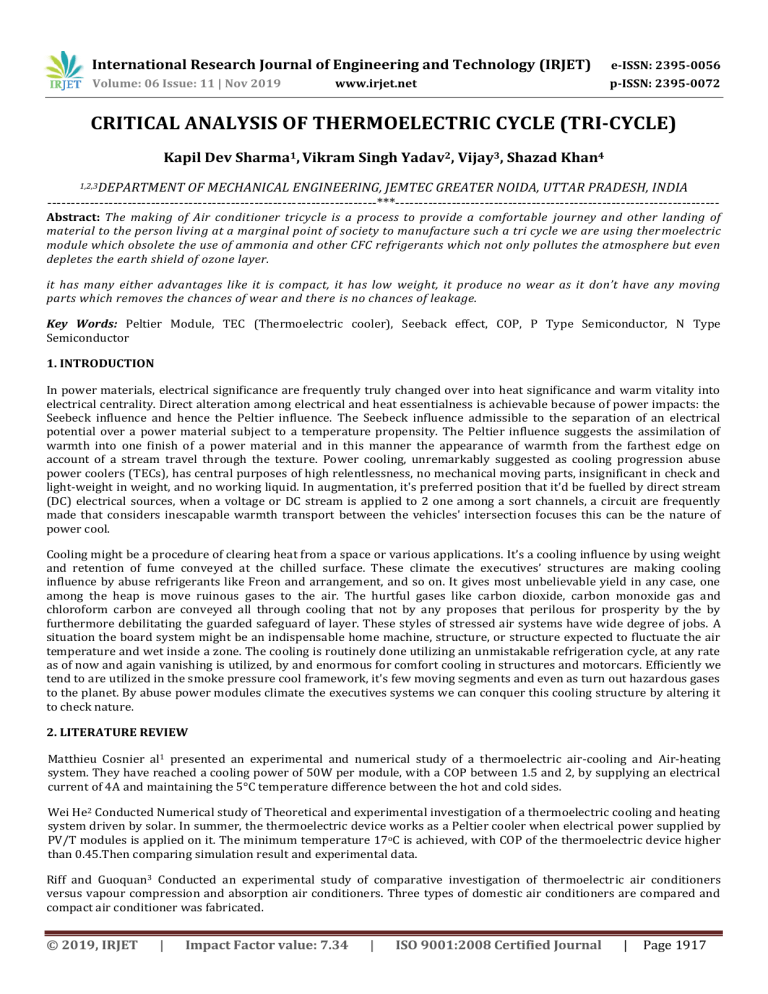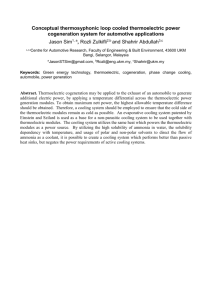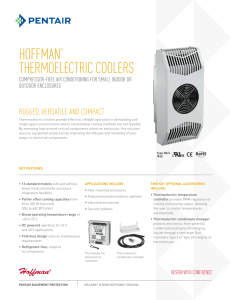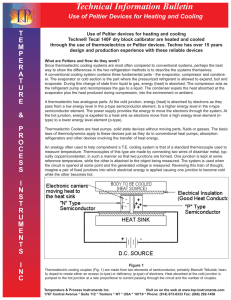IRJET-Critical Analysis of Thermoelectric Cycle (Tri-Cycle)
advertisement

International Research Journal of Engineering and Technology (IRJET) e-ISSN: 2395-0056 Volume: 06 Issue: 11 | Nov 2019 p-ISSN: 2395-0072 www.irjet.net CRITICAL ANALYSIS OF THERMOELECTRIC CYCLE (TRI-CYCLE) Kapil Dev Sharma1, Vikram Singh Yadav2, Vijay3, Shazad Khan4 1,2,3DEPARTMENT OF MECHANICAL ENGINEERING, JEMTEC GREATER NOIDA, UTTAR PRADESH, INDIA ----------------------------------------------------------------------***--------------------------------------------------------------------- Abstract: The making of Air conditioner tricycle is a process to provide a comfortable journey and other landing of material to the person living at a marginal point of society to manufacture such a tri cycle we are using ther moelectric module which obsolete the use of ammonia and other CFC refrigerants which not only pollutes the atmosphere but even depletes the earth shield of ozone layer. it has many either advantages like it is compact, it has low weight, it produce no wear as it don’t have any moving parts which removes the chances of wear and there is no chances of leakage. Key Words: Peltier Module, TEC (Thermoelectric cooler), Seeback effect, COP, P Type Semiconductor, N Type Semiconductor 1. INTRODUCTION In power materials, electrical significance are frequently truly changed over into heat significance and warm vitality into electrical centrality. Direct alteration among electrical and heat essentialness is achievable because of power impacts: the Seebeck influence and hence the Peltier influence. The Seebeck influence admissible to the separation of an electrical potential over a power material subject to a temperature propensity. The Peltier influence suggests the assimilation of warmth into one finish of a power material and in this manner the appearance of warmth from the farthest edge on account of a stream travel through the texture. Power cooling, unremarkably suggested as cooling progression abuse power coolers (TECs), has central purposes of high relentlessness, no mechanical moving parts, insignificant in check and light-weight in weight, and no working liquid. In augmentation, it's preferred position that it'd be fuelled by direct stream (DC) electrical sources, when a voltage or DC stream is applied to 2 one among a sort channels, a circuit are frequently made that considers inescapable warmth transport between the vehicles' intersection focuses this can be the nature of power cool. Cooling might be a procedure of clearing heat from a space or various applications. It’s a cooling influence by using weight and retention of fume conveyed at the chilled surface. These climate the executives’ structures are making cooling influence by abuse refrigerants like Freon and arrangement, and so on. It gives most unbelievable yield in any case, one among the heap is move ruinous gases to the air. The hurtful gases like carbon dioxide, carbon monoxide gas and chloroform carbon are conveyed all through cooling that not by any proposes that perilous for prosperity by the by furthermore debilitating the guarded safeguard of layer. These styles of stressed air systems have wide degree of jobs. A situation the board system might be an indispensable home machine, structure, or structure expected to fluctuate the air temperature and wet inside a zone. The cooling is routinely done utilizing an unmistakable refrigeration cycle, at any rate as of now and again vanishing is utilized, by and enormous for comfort cooling in structures and motorcars. Efficiently we tend to are utilized in the smoke pressure cool framework, it's few moving segments and even as turn out hazardous gases to the planet. By abuse power modules climate the executives systems we can conquer this cooling structure by altering it to check nature. 2. LITERATURE REVIEW Matthieu Cosnier al1 presented an experimental and numerical study of a thermoelectric air-cooling and Air-heating system. They have reached a cooling power of 50W per module, with a COP between 1.5 and 2, by supplying an electrical current of 4A and maintaining the 5°C temperature difference between the hot and cold sides. Wei He2 Conducted Numerical study of Theoretical and experimental investigation of a thermoelectric cooling and heating system driven by solar. In summer, the thermoelectric device works as a Peltier cooler when electrical power supplied by PV/T modules is applied on it. The minimum temperature 17oC is achieved, with COP of the thermoelectric device higher than 0.45.Then comparing simulation result and experimental data. Riff and Guoquan3 Conducted an experimental study of comparative investigation of thermoelectric air conditioners versus vapour compression and absorption air conditioners. Three types of domestic air conditioners are compared and compact air conditioner was fabricated. © 2019, IRJET | Impact Factor value: 7.34 | ISO 9001:2008 Certified Journal | Page 1917 International Research Journal of Engineering and Technology (IRJET) e-ISSN: 2395-0056 Volume: 06 Issue: 11 | Nov 2019 p-ISSN: 2395-0072 www.irjet.net Riffat and Qiu4 compared performances of thermoelectric and conventional vapor compression air-conditioners. results show that the actual COPs of vapor compression and thermoelectric air-conditioners are in the range of 2.63.0 and 0.380.45, respectively. However, thermoelectric air conditioners have several advantageous features compared to their vaporcompression counterparts.When current is passed through the dissimilar material, heat is absorbed or liberated at the junction. This Phenomenon is known as Peltier Effect. 3. PROCESS OF AIR CONDITIONING Cooling sway happens once the current experiences at any rate one immeasurable segments from n-type to ptype; there's a decreasing in temperature at the convergence ("cold side"), realizing the upkeep of heat from the planet. The glow is passed on .the segments by lepton transport and free despite what may be expected aspect because the electrons move from a higher-essentialness state to bring down vitality state. The Peltier heat diffusion is given by Q = P* I* t. wherever P is Peltier constant, I is on the market and t is time. One mastermind thermoelectric cooler will convey a biggest temperature qualification of 70°C. In any case, II-VI Marlow's Triton ICE thermoelectric Cooler can chill contraptions the maximum amount as 2°C beneath stream grandstand commitments 4. FIBRE SHEET MATERIAL Epoxy Fiberglass Sheet is a solid unbending sheet material comprises of Fiber Glass Cloth and Epoxy Resin as a fastener relieved under explicit warmth and weight. Epoxy Fiberglass Sheet has magnificent physical quality, heat opposition, dampness obstruction and electrical properties. EBFG based material can be utilized at temperatures up to 140-160oC. 5. PELTIER MODULE Thermoelectric cooling has quickly become a practical proposition for many types of electronic equipment. Devices on the market today are compact, efficient and – with the benefit of advanced internal construction – overcome the traditional reliability challenges that have restricted opportunities for this type of device in the past. FIG: 1 Peltier Module Keeping electronic components like laser diodes or image sensors at a stable temperature is vital to ensure instruments such as high-power lasers, laboratory references, spectroscopes or night-vision systems can function correctly. In some cases, cooling to below ambient temperature may be required. Simple passive cooling, using a combination of a heat sink and forced-air, can struggle to satisfy either of these demands; response to changes in thermal load can be slow and imprecise, and cooling relies on a thermal gradient where the heat source temperature is higher than ambient. © 2019, IRJET | Impact Factor value: 7.34 | ISO 9001:2008 Certified Journal | Page 1918 International Research Journal of Engineering and Technology (IRJET) e-ISSN: 2395-0056 Volume: 06 Issue: 11 | Nov 2019 p-ISSN: 2395-0072 www.irjet.net 6. CONVENTIONAL AIR CONDITIONER V/S THERMOELECTRIC AIR CONDITIONER While most traditional refrigeration systems use designs based on compressors and refrigerants, more and more applications are turning to thermoelectric cooling as an alternative to traditional refrigeration technology. While thermoelectric cooling isn’t viable for every refrigeration, thermoelectric modules can significantly outperform traditional refrigerant-based cooling systems in certain applications. Solid state design No moving parts Integrated chip design No hazardous gases Silent operation Compact and lightweight Low profile Sizes to match your component footprint No bulky compressor units Perfect for benchtop applications High reliability 100,000 hours + MTBF Precise temperature stability Tolerances of better than +/- 0.1°C Accurate and reproducible ramp and dwell times Cooling/heating mode options Fully reversible with switch in polarity Supports rapid temperature cycling 7. K TYPE THERMOCOUPLE The type K is the most common type of thermocouple. It’s inexpensive, accurate, reliable, and has a wide temperature range. The type K is commonly found in nuclear applications because of its relative radiation hardness. Maximum continuous temperature is around 1,100C . FIG: 2 K type thermocouple © 2019, IRJET | Impact Factor value: 7.34 | ISO 9001:2008 Certified Journal | Page 1919 International Research Journal of Engineering and Technology (IRJET) e-ISSN: 2395-0056 Volume: 06 Issue: 11 | Nov 2019 p-ISSN: 2395-0072 www.irjet.net 7.1. Type K Temperature Range: Thermocouple grade wire, –454 to 2,3000F (–270 to 12600C) Extension wire, 32 to 392F (0 to 2000C) 7.2. Type K Accuracy (whichever is greater): Standard: +/- 2.2C or +/- .75% Special Limits of Error: +/- 1.1C or 0.4% 8. CONCLUSION Follow conclusions have been made by critical analysis that this system is advisable because it has a small size factor advantage, it has a low weight which makes it more easy to transport and thereafter also reducing the cost of storing and shipping. Also it has the advantage over the conventional air conditioner systems as their will not be any wear in the system over the time as there is no mechanical parts, or leakage over the time as there is no working fluid present in the system. This system is more safe to use as there is no environmental hazards being imparted from the system as traditional system does release CFC’s and other harmful gases. The running cost makes the system way more efficient than the traditional one. But the efficiency of the system as of current scenario is very low as compared to the traditional Air Conditioners but as the technology moves forward with advancement in the Peltier system, this system will definitely will be an alternative t a much safer and economical replacement to the traditional Air conditioners. 9. REFERENCES 1. ElCosnier W., Gilles M., Lingai., An experimental and numerical study of a thermoelectric air-cooling and air-heating system. International journal of refrigeration, 31, 1051 – 1062, (2008). 2. Sujin., Vora and Seetawan., Analyzing of Thermoelectric Refrigerator Performance. Proceedings of the 2ndInternational Science, Social-Science, Engineering and Energy Conference, 25,154–159,(2000) . 3. Wei., Jinzhi., Jingxin & Chen.,Theoretical and experimental investigation on a thermoelectric cooling and heating system driven by solar. Applied Energy, 107, 89–97, (2013). 4. Riffat and Guoquan., Comparitive investigation of thermoelectric air- conditioners versus vapour compression and absorption air- conditioners. Journal of Applied Thermal Engineering, 24 , 1979-1993,(2004). 5. Riffat and Qiu., Design and characterization of a cylindrical water cooled heat sink for thermoelectric airconditioners. International journal of energy research, 30 , 67-80,(2005) . 6. Astrain D., Vian J.G., & Domınguez M., Increase of COP in the thermoelectric refrigeration by the optimization of heat dissipation. Applied Thermal Engineering, 23, 2183–2200,(2003). 7. Virjoghe., Diana., Marcel & Florin., Numerical simulation of Thermoelectric System. latest trends on systems,15(2) , 630635,(2009). © 2019, IRJET | Impact Factor value: 7.34 | ISO 9001:2008 Certified Journal | Page 1920


